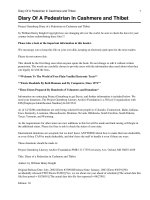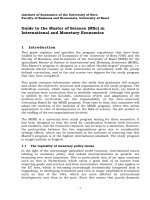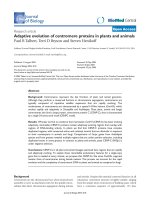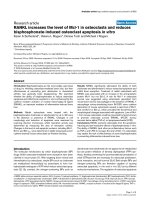Molecular interactions of tectonin proteins in host and pathogen recognition
Bạn đang xem bản rút gọn của tài liệu. Xem và tải ngay bản đầy đủ của tài liệu tại đây (12.75 MB, 194 trang )
0
MOLECULAR INTERACTIONS OF TECTONIN
PROTEINS IN HOST AND PATHOGEN RECOGNITION
DIANA LOW HOOI PING
(B. Eng (Hons.), NUS)
A THESIS SUBMITTED
FOR THE DEGREE OF DOCTOR OF PHILOSOPHY
IN COMPUTATION AND SYSTEMS BIOLOGY (CSB)
SINGAPORE-MIT ALLIANCE
NATIONAL UNIVERSITY OF SINGAPORE
2009
i
ACKNOWLEDGEMENTS
There are several people without whom this thesis would not have been at all possible
and whom I need to thank:
• Professor Ding Jeak Ling and Professor Chen Jianzhu, my supervisors, for the
guidance that they have given to me since Day 1. They have provided me great
opportunities to learn in many different environments and to learn from many
individuals with diverse backgrounds. I would like to thank Prof. Ding firstly for
helping me adapt to the world of biology, and secondly for her continuous and
dedicated effort in imparting invaluable knowledge and skills as a researcher. I
would like to thank Prof. Chen for his constant support of my work, advice and
encouraging words always.
• Singapore-MIT Alliance for their financial support of my post-graduate studies
via the SMA Graduate Fellowship.
• Dr. Sivaraman Jayaraman for his advice in my DLS experiments. Dr. Ganesh
Anand, for his manifold efforts in every part of my HDMS work. Dr. Adam Yuan
for the introduction to crystallography and help in the crystallization efforts and
also with the X-ray diffraction data collection.
• Dr. Agnès Le Saux, my mentor – I owe her a big thank you for training me to run
and design experiments, reading my progress reports and thesis, and giving me
priceless advice on lab work. Merci beaucoup, vous êtes une bonne maitresse.
• Dr. Vladimir Frecer - for helping me with all the computational studies, reading
the many manuscript drafts and working thru emails. Also thank you for the
incredible time in Trieste – work and play was equally hard but was so much fun.
ii
• My lab mates, past and present, for the camaderie and the help rendered in all
aspects of lab life, and life in general. To the late-night workers - your company,
stories, anecdotes, advice and laughter are much appreciated.
• MIT-CCC, J.U.S.T. Us – Thank you for the prayer support & encouragement and
for being constant reminders on where our hope, faith and focus should always be.
• Last but not least, I would like to thank the people closest to me – Dad, Mom, Chris
and Grace - for always being there for me and listening to everything
, even from afar,
and for reminding me to always take it easy, and have a sense of humour in
everything I do.
This thesis is dedicated
“ to Him who is able to do exceedingly abundantly above all that we ask or think,
according to the power that works in us”
Eph 3:20
iii
TABLE OF CONTENTS
Acknowledgements i
Table of Contents iii
Summary vi
List of Tables viii
List of Figures viiii
List of Abbreviations xiii
List of Primers xv
1 General introduction and overview
1.1 Overview of the innate immune system ……………………………. 1
1.1.1 The prophenoloxidase pathway ………………………………… 4
1.1.2 The complement system ………………………………………… 5
1.1.3 Serine proteases as activators and enhancers of immune response 6
1.2 Recognition of pathogens and activation of the innate immune system 9
1.2.1 Pathogen recognition receptors - CRP and GBP as key innate
immune molecules ……………………………………………. 9
1.2.2 The beta-propeller structure and proteins ……………………… 10
1.2.3 The interactome hypothesis ……………………………………. 15
1.2.4 Pathogen associated molecular patterns ……………………… 17
1.2.4.1 Lipopolysaccharide ……………………………………. 18
1.2.4.2 Lipid A ……………………………………………… 21
1.2.5 Antimicrobial peptides ……………………………………………. 22
1.3 Horseshoe crab as an ideal experimental model host for innate immunity
study …………….……………………………………………………… 24
1.4 Overview of thesis …………………………………………………… 26
2 Materials and Methods
2.1 Computational Analysis
2.1.1 Bioinformatics analysis …………………………………………… 27
2.1.2 Protein homology modeling ………………………………………. 27
2.1.3 Construction of bacterial and saccharide structures ………………. 29
2.1.4 Protein-protein and protein-ligand docking ……………………… 29
2.1.5 Identification of LPS-binding motifs ……………………………… 30
2.1.6 Design and synthesis of LPS-binding peptides …………………… 30
2.2 Preparative Methods
2.2.1 Organisms …………………………………………………………. 31
2.2.2 Biochemicals and enzymes …………………………………… 31
2.2.3 Medium and agar …………………………………………………. 32
2.2.4 Collection of cell-free hemolymph ……………………………… 33
iv
2.2.5 Depyrogenation of equipment and buffers ……………………… 33
2.2.6 Purification of GBP from cell-free hemolymph ……………… 33
2.3 Analytical Methods
2.3.1 SDS-PAGE analysis ……………………………………………. 34
2.3.2 Western blot ……………………………………………………. 34
2.3.3 Mass spectrometry ……………………………………………. 35
2.3.4 ELISA ……………………………………………………………. 36
2.3.5 Yeast 2-hybrid co-transformation assay ………………………… 37
2.3.6 Yeast 2-hybrid library screening ………………………………… 39
2.3.7 Dynamic light scattering analysis ……………………………… 42
2.3.8 Protein crystallization ……………………………………………. 42
2.3.9 Amide hydrogen exchange mass spectrometry (HDMS)
and data analysis ………………………………………………… 42
2.3.10 Surface plasmon resonance analysis ……………………………. 45
2.3.11 Pyrogene assay for endotoxicity ………………………………… 45
3 GBP, a representative Tectonin protein in innate immune defense
3.1 Introduction
3.1.1 Tectonin domains in beta-propeller repeats ………… ………… 47
3.1.2 Lectins …………………………………………………………… 51
3.1.3 The Tectonin domain …………………………………………… 55
3.2 Results and Discussion
3.2.1 Biochemical properties of GBP ………………………………… 56
3.2.1.1 Purified GBP shows polymeric forms ………………… 56
3.2.1.2 GBP is a multimeric complex in solution ………………… 60
3.2.1.3 Purified GBP retains saccharide-binding function …… 62
3.2.2 The GBP structure………………………………………………… 63
3.2.2.1 Crystallization of GBP and CRP for structure determination 63
3.2.2.2 Computational modeling of GBP and CRP structure ……… 66
3.2.2.3 Saccharides and LA dock to similar sites in GBP ……… 74
3.2.3 Molecular mechanism of GBP:LPS interaction ………………… 78
3.2.3.1 GBP interacts with LPS via sugar groups ………………… 78
3.2.3.2 The different lengths of LPS bind strongly to GBP ……… 79
3.2.3.3 The interaction between GBP and LPS is independent of Ca
2+
81
3.2.3.4 GBP interacts with LPS via distinct interaction surfaces … 82
3.2.4 Mechanism of action of GBP : CRP interaction ………………… 85
3.2.4.1 HDMS reveals that GBP interacts with CRP through
a non-symmetrical protein-protein contact ………………. 85
3.2.4.2 Yeast 2-hybrid interaction analyses show consistent
interaction domains with HDMS observations ………… 90
3.2.4.3 Protein-protein docking reaffirms the feasibility of
GBP:CRP binding region ………………………………… 91
v
3.2.5 Effects of infection on the GBP, CRP and LPS interactions ……… 93
3.2.5.1 Infection enhances interaction between GBP and CRP to LPS 93
3.2.5.2 Infection causes irreversible conformational change to GBP
and CRP ……………………………………………………. 96
3.2.5.3 GBP and CRP binds and disrupts LPS micelles and exposes
its endotoxicity …………………………………………… 97
3.3 Summary ………………………………………………………………. 99
4 hTectonin – Discovery of a novel Tectonin protein in the human
4.1 Introduction ………………………………………………………………. 101
4.1.1 Are the Tectonin proteins evolutionary conserved? Do PRR:PRR
interactomes exist in the human system? …………………………… 101
4.2 Results and Discussion
4.2.1 hTectonin – a distantly related homolog of the invertebrate Tectonins
4.2.1.1 hTectonin is widely present across the various species …… 104
4.2.1.2 hTectonin β-sheets are highly conserved …………………… 106
4.2.2 In search for interaction partners of hTectonin
4.2.2.1 hTectonin gene is expressed in immune cell lines ………. 107
4.2.2.2 hTectonin interacts with immune-related molecules in the
leukocyte library …………………………………………… 108
4.2.2.3 hTectonin interacts with ficolin …………………………… 114
4.2.2.4 hTectonin protein expression increases in response to LPS
stimulation ……………………………………………… 115
4.2.3 LPS-binding peptides in Tectonins ……………………………… 116
4.2.3.1 An algorithm was developed for large-scale screening of LPS-
binding motifs in proteins …… ………………………… 117
4.2.3.2 hTectonin contains LPS-binding motifs …………………… 119
4.2.3.3 Designed predicted LPS-binding peptides are hydrophilic,
synthetically feasible and suitable for binding analysis…… 120
4.2.3.4 hTectonin- and GBP-derived Tectonin peptides bind LPS
with high affinity …………………………………………… 122
4.3 Summary …………………………………………………………………… 125
4.4 Common features between GBP and hTectonin ……………………… 126
5 Conclusion ……………………………………………………………… 128
6 Future perspectives …………………………………………………… 132
7 References ………………………………………………………………. 135
8 Publications
9 Appendix A
vi
SUMMARY
Beta-propeller proteins exhibit diverse functions in catalysis, protein-protein
interaction, cell-cycle regulation, and immunity. Tectonins, a sub-class of β-propeller
family, have been implicated in bacterial binding. Our prediction revealed that the
galactose-binding protein (GBP) in the horseshoe crab, Carcinoscorpius
rotundicauda, is an all-beta sheet protein consisting of Tectonin domains. Studies
have shown that upon binding to Gram-negative bacterial lipopolysaccharide (LPS),
GBP interacts with C-reactive protein (CRP) and carcinolectin (CL5) to form a
pathogen recognition complex. However, the molecular basis of interactions between
GBP and LPS and how it interplays with CRP remains largely unknown. Here, we
sought to unravel the mechanisms of interaction by examining the structure-function
relationship, with a view to understanding the pathophysiological implications of the
Tectonin domain-containing proteins and the possible conservation of this concept in
the mammalian system. Through homology modeling, GBP was revealed to be a 6 β-
propeller toroidal structure. Interestingly, the seemingly repetitive and identical
domains were able to simultaneously bind LPS and CRP via separate domains,
suggesting that the Tectonin domains can differentiate self/non-self, which is crucial
to frontline defense against infection. Infection condition, which was mimicked by
Ca
2+
chelation, increased the GBP-CRP affinity by 1000-fold. Re-supplementing the
system with physiological levels of Ca
2+
did not reverse the protein-protein affinity to
basal state, suggesting that the infection-induced complex had undergone irreversible
conformational changes. GBP was also able to increase the endotoxicity of LPS,
prompting suggestions that it probably disrupts LPS micelles and exposes the
endotoxic potential of LPS. In vivo, this may translate into the ability of GBP to bind
vii
LPS and perturb the Gram-negative bacterial outer membrane while serving to prime
the immune system for stronger downstream immune response. Phylogenetic analysis
revealed strong evolutionary conservation of the Tectonin homologues from the
plasmodium to human. We identified the hTectonin, a then hypothetical protein in the
human genome database, as a potential distant homolog of GBP. hTectonin, like GBP,
formed β-propellers with multiple Tectonin domains. It is present in the human
leukocyte and interacts with M-ficolin, a known human complement protein whose
ancient homolog, CL-5, is the functional protein partner of GBP. Furthermore, the
affinity of hTectonin-derived LPS-binding peptides is comparable to that of the GBP-
derived peptides. By virtue of a recent finding of another Tectonin protein called the
leukolectin in the human leukocyte we propose that the Tectonin proteins could play
an important role in innate immune defense and that this function has been conserved
over several hundred million years, from invertebrates to vertebrates.
viii
LIST OF TABLES
Table No. Title
Page
Chapter 1
1.1
The various functions of β-propeller proteins
13
Chapter 3
3.1 Purification summary of GBP
59
3.2 DLS measurements for GBP of molecular radius, diffusion
coefficient and molecular weight in solution over time
61
3.3 List of crystallization kits used in attempts to crystallize
GBP and CRP
64
3.4 Data obtained from CRP crystal diffraction
65
3.5 List of Phi-Psi outliers in the GBP model
68
3.6 List of Phi-Psi outliers in the CRP model
73
3.7 Computed binding energies for top scoring saccharides and
lipid A poses docked to GBP
76
3.8 Rate constants and equilibrium dissociation constants of
binding kinetics of ligands to GBP
80
3.9 Summary of H/
2
H exchange data for GBP
88
3.10 Summary of H/
2
H exchange data for GBP
89
Chapter 4
4.1 Putative interaction partners of hTectonin identified via
yeast 2-hybrid screening of the human leukocyte cDNA
library
110
4.2 Dissociation constants of Tectonin peptides when bound to
LPS, ReLPS, lipid A
125
ix
LIST OF FIGURES
Figure No. Figure Title
Page
Chapter 1
1.1 Innate immunity
2
1.2 The innate immune system plays a critical role in adaptive
immunity
4
1.3 The prophenoloxidase pathway in invertebrates
5
1.4 The complement cascade
6
1.5 The coagulation cascade in the horseshoe crab
7
1.6 Serine proteases regulate the assembly of PRRs to prompt
the innate immune response
8
1.7 Structures of hCRP, TtCRP and LpCRP
10
1.8 The structure of TL-1
11
1.9 Oligomers of TPL-1 and GBP
11
1.10 An example of a beta-propeller fold formed by 4 anti-
parallel β-strands
12
1.11 Examples of beta propeller proteins with different number
of folds
14
1.12 Features of the β-propeller structure
14
1.13 CRP interacts with GBP upon host infection
15
1.14 A model for pathogen recognition assembly via interaction
between CrOctin and other PRRs in the horseshoe crab
16
1.15 Protein interaction network of GBP and CRP
16
1.16 Bacterial PAMPs and their recognition by various PRRs
17
1.17 Schematic diagram of the cell wall of Gram-negative
bacteria
19
1.18 Structural organization of LPS in the Enterobacteriaceae
20
x
1.19 Detailed chemical structure of the Salmonella minnesota
LA
18
1.20 The different mechanisms of action of antimicrobial
peptides
21
1.21 The horseshoe crab
24
Chapter 2
2.1 Cloning of genes into yeast 2-hybrid vectors
38
2.2 Colony selection of succesful transformants
39
2.3 Hydrogen exchange mass spectrometry
43
Chapter 3
3.1 Identified conserved sequence motifs in known beta-
propeller repeats such as the WD-repeat, Kelch, YWTD
and others
49
3.2 The 3D structure of the heterotrimeric G-protein complex
50
3.3 The 3D structure of neuraminidase
51
3.4 Sialic acid structural analogues and their mechanism of
action
51
3.5 Schematic examples of major types of animal lectins,
based on protein structure
52
3.6 Mechanism of saccharide binding observed in symmetrical
β-propeller fold structures
53
3.7 Plasmodium stage of Physarum polycefalum
55
3.8 Consensus sequence for the definition of a Tectonin
domain
56
3.9 GBP is co-purified with partners at pH7.4
58
3.10 GBP is purified at pH8.8
58
3.11 Electrophoretic analyses of GBP
59
3.12 Mass spectrometry analysis of purified GBP bands
60
xi
3.13 GBP exists in polymeric form
61
3.14 OD405 measurements during GBP purification
62
3.15 GlcNAc-removed GBP is able to re-bind Sepharose
63
3.16 Crystals of GBP and CRP
65
3.17 X-ray diffraction pattern of CRP crystal
65
3.18 Secondary structure prediction of GBP
66
3.19 The 6 internal tandem repeats in the sequence of GBP
66
3.20 Sequence alignment of GBP to Tachylectin-1
67
3.21 The Ramachandran plot of the GBP homology-modeled
structure
68
3.22 Homology model of GBP structure
69
3.23 The protein sequence of GBP showing 6 Tectonin domain
repeats
69
3.24 Cysteine residues of GBP
70
3.25 Surface properties of GBP
71
3.26 Prediction of flexible residues on GBP
71
3.27 The structure of the homology modeled CRP
72
3.28 Ramachandran plot for the structure of CRP
73
3.29 Saccharides dockin to the hydrophobic clefts and central
cavity of GBP
75
3.30 LA docks to the hydrophobic cleft of GBP
77
3.31 The sugar moieties of LPS and LTA bind to GBP
79
3.32 GBP binds LPS with high affinity
80
3.33 The interaction between GBP and LPS is independent of
Ca
2+
81
3.34 Example of HDMS mass shift in the GBP sample
82
xii
3.35 HDMS analysis – surface interaction of GBP with either
GlcNAc or LA
84
3.36 HDMS analysis – surface interaction of GBP with CRP
86
3.37 HDMS analysis – surface interaction of CRP with GBP
87
3.38 Yeast 2-hybrid analysis shows specific Tectonin domains
of GBP interact with CRP
91
3.39 Guided docking of the GBP-CRP interaction
93
3.40 Binding affinity of infected GBP
94
3.41 Effect of infection upon GBP-CRP interaction with LA
95
3.42 Effect of calcium on infected proteins binding to LA
96
3.43 GBP and CRP exposes LPS endotoxicity
98
3.44 Molecular size of GBP polymers increase with addition of
LPS
99
3.45 Model of micelle disruption to increase LPS endotoxicity
99
3.46 Proposed mechanism of GBP interactions and formation of
the pathogen recognition complex for innate immune
response
100
Chapter 4
4.1 hTectonin is distantly related to the invertebrate Tectonins
105
4.2 The hTectonin gene is widespread across many species
106
4.3 hTectonin forms β-sheets in its Tectonin repeats
107
4.4 hTectonin cDNA is found in the human T cells (A549),
monocytes (U937) and leukocytes
108
4.5 Selected hTectonin partners for interaction confirmation
114
4.6 hTectonin interacts with ficolin
115
4.7 hTectonin protein expression increases in response to LPS
stimulation
116
4.8 Algorithm workflow of the LPS motif search application
118
xiii
4.9 The LPSMotif program
118
4.10 LPS-binding motifs in Tectonin proteins
119
4.11 hTectonin LPS-binding motifs conserved in other species
120
4.12 Hydrophobicity plots analysis of GBP and hTectonin
peptides
121
4.13 Peptides derived from the Tectonin domains of GBP and
hTectonin bind LA with high affinity
123
4.14 Peptides derived from the Tectonin domains of GBP and
hTectonin also bind LPS and ReLPS with high afiinity
124
xiv
LIST OF ABBREVIATIONS
ABTS 2,2'-azino-bis[3-ethylbenzthiazoline-6-sulfonic] acid
BLAST Basic local alignment search tool
BSA Bovine serum albumin
cDNA Complementary deoxyribonucleic acid
CFU Colony-forming unit
CL-5 Carcinolectin-5
CRD Carbohydrate recognition domain
CRP C-reactive protein
CTL Cytotoxic T lymphocytes
dATP Deoxyadenosine triphosphate
dCTP Deoxycytosine triphosphate
DEPC Diethylpyrocarbonate
dGTP Deoxyguanosine triphosphate
DLS Dynamic light scattering
DMSO Dimethyl sulfoxide
dNTP Deoxyribonucleoside triphosphate
DO Drop out
dTTP Deoxythymidine triphosphate
EDTA Ethylene diamine tetra acetic acid
EGTA Ethylene glycol tetra acetic acid
ELISA Enzyme-linked immunosorbent assay
Gal Galactose
GBP Galactose-binding protein
GlcNAc N-acetyl-glucosamine
h Hours
HDMS Hydrogen deuterium exchange mass spectrometry
HMC Hemocyanin
hpi Hours post-infection
IPTG Isopropyl-1-thio-β-D-galactopyranoside
kb Kilobase
kDa KiloDalton
KDO 2-keto-3-deoxyoctonate
LA Lipid A
LB Luria-Bertani
LPS Lipopolysaccharide
LTA Lipoteichoic acid
M Molar
m/z Mass/charge
xv
MALDI-TOF Matrix-assisted laser desorption ionization-time of flight
min Minute
MOE Molecular Operating Environment
MOWSE Molecular Weight Search
OD Optical density
P. aeruginosa Pseudomonas aeruginosa
PAMP Pathogen-associated molecular pattern
PBS Phosphate-buffered saline
PCR Polymerase chain reaction
PDB Protein data bank
PMSF Phenylmethylsulphonylfluoride
PRR Pattern recognition receptors
PSIPRED Protein secondary structure prediction software
QDO Quadruple drop out
ReLPS Lipopolysaccharide that is truncated to the “e” portion of its RR-
core-polysaccharide
s Seconds
SD Synthetic defined
SDS Sodium Dodecyl Sulfate
SMART Simple molecular alignment research tool
SPR Surface Plasmon resonance
TBS Tris-buffered saline
TBST Tris-buffered saline with Tween-20
TEMED Tetramethylethylenediamine
v/v Volume/volume ratio
w/v Weight/volume ratio
YPDA Yeast extract, peptone, dextrose, adenine
xvi
LIST OF PRIMERS
Name Sequence (5’ – 3’) Amino acid
sequence
Purpose
GBP gene specific primers
GBP-1F-NdeI gcccatatgGAATGGA
CCCACATTAATGG
A
AEWTHIN Forward primer for
cloning GBP from
domain 1 into pGBKT7
GBP-2F-NdeI cgcatatgAGCAACTG
GATAAAAGTGGAA
GG
SNWIKVE Forward primer for
cloning GBP from
domain 2 into pGBKT7
GBP-3F-NdeI cgcatatgGGAAGTTG
GACACAAATCAA
GSWTQIK Forward primer for
cloning GBP from
domain 3 into pGBKT7
GBP-4F-NdeI cgcatatgGGGGAATG
GGAATTGGTAGAT
GEWELVD Forward primer for
cloning GBP from
domain 4 into pGBKT7
GBP-5F-NdeI cgcatatgGGTGTCTG
GGAGAACATCC
GVWENIP Forward primer for
cloning GBP from
domain 5 into pGBKT7
GBP-6F-NdeI ATTTTCGAGTCAG
TCCCTTAActcgaggc
c
GQWVRLP Forward primer for
cloning GBP from
domain 6 into pGBKT7
GBP-1R-EcoRI gcgaattcttaACCGGTA
CACGGTCG
RCTRPCTG Reverse primer for
cloning GBP from
domain 1 into pGBKT7
GBP-2R-EcoRI cggaattcttaAGTACCA
TCCACTGGCC
YKRPVDGT Reverse primer for
cloning GBP from
domain 2 into pGBKT7
GBP-3R-EcoRI cggaattcttaATTACAA
GGCTTAGGACATT
TG
FKCPKPCN Reverse primer for
cloning GBP from
domain 3 into pGBKT7
GBP-4R-EcoRI gcgaattcttaACTGCCG
TCAACGGG
YRRPVDGS Reverse primer for
cloning GBP from
domain 4 into pGBKT7
xvii
GBP-5R-EcoRI cggaattcttaTGAACAA
GGTTTCTTGCAGC
G
FRCKKPCS Reverse primer for
cloning GBP from
domain 5 into pGBKT7
GBP-6R-XhoI ggcctcgagttaTAGGA
AAGGATTCAACCA
GCA
DDIFESVP Reverse primer for
cloning GBP from
domain 6 into pGBKT7
hTectonin specific primers
BC053591-F-
HindIII
gcgaagcttatgCCCAAC
TCAGTGCTGTGG
ATGCCCAA Forward primer for
cloning hTectonin from
into pGBKT7
BC053591-R-
XhoI
gcgctcgagGCAGCAG
ACGGGGCCATGGG
C
GCTGCTGA Reverse primer for
cloning hTectonin from
into pGBKT7
All primers were reconsituted in water to 100 μM stock and stored at -20 °C.
1
CHAPTER 1
GENERAL INTRODUCTION AND OVERVIEW
1.1 Overview of the innate immune system
The innate immune system serves to protect the host from microbial infection and is
thought to be the dominant host defense system in many organisms (Litman et al.
2005). The innate response is usually triggered when microbes are identified by
pattern recognition receptors (PRRs) present in the host (Figure 1.1), which recognize
components that are conserved among broad groups of microorganisms (Medzhitov
2007). These microbe-specific molecules that are recognized by a given PRR are
called pathogen-associated molecular patterns (PAMPs) and include bacterial
carbohydrates (e.g. lipopolysaccharide (LPS)), nucleic acids (e.g. bacterial or viral
DNA or RNA), bacterial peptides (flagellin), peptidoglycans and lipotechoic acids
(from Gram-positive bacteria), N-formylmethionine, lipoproteins and fungal glucans.
PRRs also recognize damaged, injured or stressed cells that send out alarm signals,
many of which are recognized by the same receptors as those that recognize
pathogens (Matzinger 2002).
Although it does not give long-lasting protection to the host, the innate immune
system is crucial in providing immediate defense against infection (Janeway and
Medzhitov 2002) in all classes of plant and animal life, and is the only form of
immune defense in the invertebrates. The invertebrate innate immune system employs
several mechanisms to recognize and eliminate pathogens: (i) prophenoloxidase
pathway to oxidatively kill invading microorganisms, (ii) complement-mediated
antimicrobial action, (iii) blood coagulation to immobilize the invading microbes, (iv)
2
lectin-induced complement pathway to lyse and opsonize the pathogen, and (v)
prompt synthesis of potent effectors, such as antimicrobial peptides (Ding et al. 2004).
Figure 1.1: Innate immunity. PRRs of the innate immune system recognizes pathogens and
activate downstream innate defense modules like coagulation pathway, complement pathway
and also induce further action by the adaptive immune system. Figure adapted from
Medzhitov (2007).
Inflammation is one of the first responses of the innate immune system to infection or
tissue injury. Inflammation is stimulated by chemical factors (Sturtinova 1995)
released by the affected cells and serves to establish a physical barrier against the
spread of infection, and to promote healing of any damaged tissue following the
clearance of pathogens. Another branch of innate immune response is through the
complement pathway. It is a biochemical cascade of the immune system that helps, or
“complements”, the ability of antibodies to clear pathogens or mark them for
destruction by other cells (Janeway 2005). The complement cascade is made up of the
classical, alternate and lectin-mediated pathways that are composed of many small
3
plasma proteins. Complement components can be found in many species
evolutionarily older than mammals including plants, birds, fish and some species of
invertebrates for example the horseshoe crab, which is dubbed the “living fossil”, with
evolutionary history of several hundred million years (Zhu et al. 2005). The
conservation of the complement system from the horseshoe crab to humans reflects
the significance of the innate immune armament to curb pathogen invasion.
The delayed response of the adaptive immune system requires that the innate immune
system continues to serve as the frontline defense system even for vertebrates.
Research has shown that the adaptive immune system is not independent of the innate
immune system (Medzhitov and Janeway 1997; Katsikis et al. 2007). Rather, it is
influenced by recognition signals from the innate immune system as an input to help
shape its development and utilizes the effector apparatus of the innate immune system
as part of its ammunition towards invaders (Figure 1.2). Downstream consequences
of the immune response include the recruitment of complement components of the
innate immune system by antibodies – phagocytic macrophages and dendritic cells
"present" antigens to T-cells to initiate both cell-mediated and antibody-mediated
adaptive immune responses. The interaction of PAMPs and Toll-like receptors
(TLRs) on dendritic cells causes them to secrete cytokines, including interleukin 6
(IL-6), which interfere with the ability of regulatory T-cells to suppress the responses
of effector T-cells to the antigen (Kimball 1994).
4
Figure 1.2: The innate immune system plays a critical role in adaptive immunity.
Components of the innate immune system (e.g. the TLRs) recognize PAMPs; they process
and prepare the pathogen to be presented to the T-cells of the adaptive immune system. Figure
adapted from
1.1.1 The prophenoloxidase pathway
The prophenoloxidase (PPO) pathway (Figure 1.3) is a major defense pathway in the
invertebrates (Cerenius and Soderhall 2004). The activation of PPO to phenoloxidase
(PO) results in the production of the highly reactive cytotoxic quinine which produces
reactive oxygen species (ROS) to kill the microbial intruder effectively. As the
toxicity of ROS poses a dilemma to the host’s own survival, its production must be
tightly controlled. When activated, the phenoloxidase oxygenates monophenols to o-
diphenols and further to o-quinones, which are intermediate products for melanin
formation. Melanin, serves as a shield to prevent the spread of the microbial intruder,
while the highly reactive intermediate products (quinines) are antimicrobial and
cytotoxic. Work in our lab also recent showed that the PPO activity of horseshoe crab
hemocyanin (HMC), initially triggered by microbial proteases, can be further
enhanced by PAMPs (Jiang et al. 2007). This demonstrates a direct antimicrobial
5
strategy by which the host opportunistically exploits the invading microbe’s virulence
factors to convert its respiratory proteins into potent ROS producers to effectively kill
the intruder.
Figure 1.3 The phenoloxidase pathway in invertebrates. β-1,3-glucan, lipopolysacharide
and peptidoglycan are bound by pattern-recognition receptors (PRRs) which then trigger a
serine protease cascade leading to the activation of the prophenoloxidase-activating enzyme
(ppA) from its pro-form. The activated ppA which is also a serine protease then cleaves the
prophenoloxidase into phenoloxidase. The phenoloxidase enzyme then converts monophenols
into quinones via oxygenation. Quinones are the intermediate compounds for melanin
formation and are highly reactive and toxic to cells. Adapted and modified from Cerenius and
Soderhall (2004).
1.1.2 The complement system
One major pathway in innate immunity that can be activated by PRRs is the
complement system. Even though it belongs to the innate immune system, it can be
recruited and brought into action by the adaptive immune system. Thus, it also acts as
an initiator of events to trigger downstream action related to the adaptive immune
system.
LPS / (1-3) β-D-glucan /
Serine protease cascade
pro-ppA ppA
prophenoloxidase phenoloxidase
quinones melanin
phenols
O
2
6
Three biochemical pathways activate the complement cascade: the classical
complement pathway, the alternative complement pathway, and the mannose-binding
lectin pathway (Janeway 2005) (Figure 1.4). Major examples of PRRs capable of
activating the complement system include C-reactive protein (CRP, classical
complement pathway) and the ficolins (lectin pathway). The complement system
consists of a number of small proteins found in the blood, normally circulating as
inactive zymogens (enzyme precursors). When stimulated by one of several triggers,
proteases in the system specifically cleave the proteins to release cytokines and
initiate an amplifying cascade of further cleavages. The end-result of this activation
cascade is massive amplification of the response and activation of the cell-killing
membrane attack complex (MAC). Over 20 proteins and protein fragments make up
the complement system, including serum proteins, serosal proteins, serine proteases
and cell membrane receptors.
Figure 1.4: The complement cascade. Major PRRs like CRP and ficolin and proteinases like
mannan-binding lectin-associated serine proteinase (MASP) can trigger the complement
cascade via the classical, lectin and alternative pathways. Once activated, a series of reactions
takes place which ultimately leads to downstream effector actions resulting in inflammation,
opsonisation of pathogens or lysis of cells via the MAC. Figure adapted with modifications
from DeFranco et. al. (2008).
7
1.1.3 Serine proteases as activators and enhancers of immune response
The serine proteases seem to be a recurrent member in many of the immune related
pathways, as can be seen in the description of the prophenoloxidase and complement
pathways above. Besides the prophenoloxidase and complement pathways, serine
proteases are also involved in the clotting pathway of vertebrates and the coagulation
pathway of the horseshoe crabs (Figure 1.5) (Ding and Ho 2001). In the horseshoe
crab, when Gram-negative bacteria invade the hemolymph, hemocytes detect LPS
molecules on their surfaces (Ariki et al. 2004). The hemocytes then release granular
components including two serine protease zymogens, named Factors C and G, which
are autocatalytically activated by LPS or (1→3)-β-D-glucan, which are major
components of the cell walls of Gram-negative bacteria and fungi, respectively.
Factor B zymogen is then activated by Factor C to its active form (Factor B’), which
activates proclotting enzyme to clotting enzyme. Clotting enzyme then converts
coagulogen to an insoluble coagulin gel (Kawasaki et al. 2000).
Figure 1.5: The coagulation cascade in the horseshoe crab. The coagulation pathway in the
horseshoe crab can be triggered by LPS which autocatalyses the Factor C zymogen into an
active serine protease, Factor C’. Factor C’ then cleaves and activates another serine protease,
Factor B, which in turn activates the proclotting enzyme. An insoluble clot forms when the
clotting enzyme activates coagulogen into coagulin. Clotting can also be triggered by (1-3) β-
D-glucan which acts via another serine protease zymogen Factor G. Activated Factor G then
taps into the coagulation pathway via cleavage of proclotting enzyme. Adapted from Ding and
Ho (2001).
LPS
Factor C
Factor B’
Factor C’
Factor B
Clotting enzyme
Proclotting
Coagulin gel clot
Coagulogen
Factor G
Factor G’
(1-3) β-D-glucan









